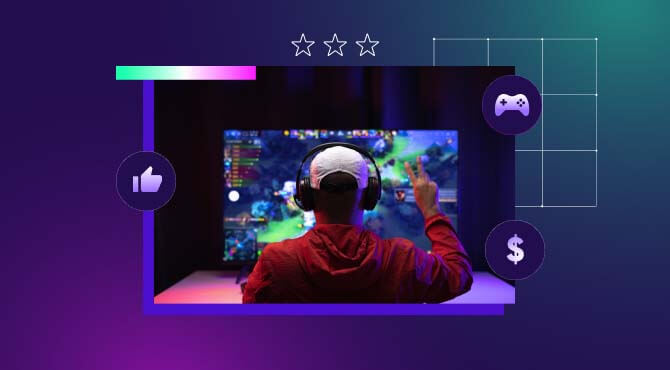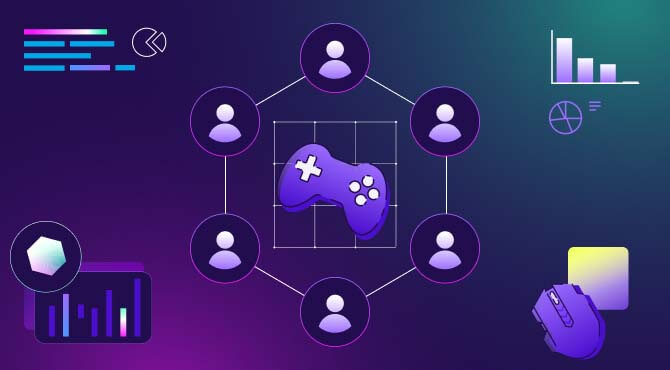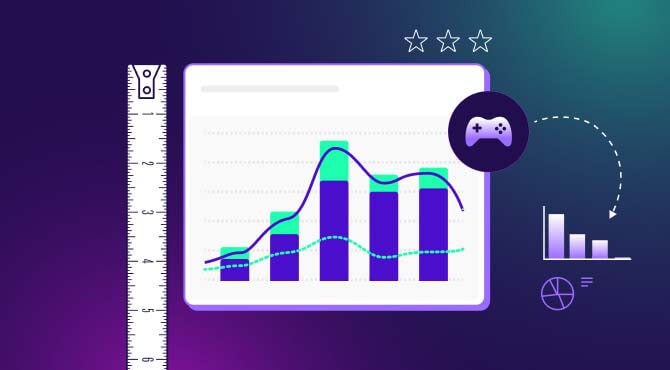There are 1.93 billion mobile gamers worldwide. For the first time in gaming history, you and your grandmother might be swiping away at the same game — or, in this one instance, your grandma might befriend a rapper from Florida via Words with Friends.
That’s because mobile games are enjoyable and accessible to everyone with a smartphone. With player numbers like this, it’s hardly surprising that the industry is projected to reach $173.4 billion by 2026.
And more players means more developers, too. With competition fiercer than ever, this guide breaks down essential marketing strategies so you can stand out above the competition.
What is mobile game marketing?
Mobile game marketing involves promoting a mobile game to attract new, high-quality players at the lowest possible cost. It can also be used to re-engage lapsed users, or to encourage in-app purchases.
Depending on your budget, target audience, and goals, your marketing strategy may involve a combination of paid and organic (unpaid) channels. This could range from optimizing your app store listings to running TikTok ad campaigns.
Although there’s no silver bullet, the foundational strategies outlined in this guide can help you create the best strategy for your mobile game. If you want a bird’s eye view of the mobile gaming industry, read our state of gaming app marketing report. It’s packed with trends, UA spend data, benchmarks, best practices, and more.
Why is mobile game marketing important?
For gaming apps, the goal is to make fun games while generating revenue. In order to do that sustainably, you need to identify marketing channels that help you acquire new players and reel in those who have drifted away.
Let’s dive into the specifics of why mobile game marketing matters.
Lets your target audience find you
You can’t build a good mobile game and expect players to naturally come to you. Hoping that your mobile game will go viral without spending a dime is unrealistic. Even if you don’t spend on Instagram and TikTok ads, you will have to invest resources in finding your target audience and letting them know that your game exists.
So, the first purpose of mobile game marketing is to increase awareness — to show your target audience that you exist in the first place.
Drives installs
Helping users find your app is one thing, but the next step is getting them to actually install it. If you crack the code on what channels work best for your game, then you’ll be able to reliably and profitably grow your game’s user base. You can also tap into new markets that may not have been possible with simply word-of-mouth marketing.
Encourages player retention
Marketing your game can also keep players interested, and even bring back those who stopped playing. By highlighting new content or offering bonus rewards to inactive users, you can increase your player base and generate more revenue at a lower cost than acquiring a completely new user.
Supports diversified revenue streams
There are multiple ways to monetize your gaming app, whether you charge for downloads, offer subscriptions or in-app purchases, or rely on in-app ads. Mobile game marketing can help you maximize these different revenue streams for sustainable growth.
If you’re able to target high-quality users, you can promote special offers and exclusive content to drive more in-app purchases. For example, you can promote a sale on bonus content or battle passes for new players.
What are the different kinds of mobile game marketing campaigns?
To reiterate, there are numerous ways to advertise your game. While some channels, such as Instagram and TikTok ads, are more popular than others, each one has its own advantages and disadvantages. We can break down the various advertising options into three categories: push, pull, and paid.
Push campaigns
Push campaigns “push” information about your game in front of your target audience — for example, through push notifications, email marketing, or CTV advertising. Push campaigns are the most common form of advertising, as you can directly reach your target audience.
Paid campaigns
Paid campaigns are a subset of push campaigns, in which you pay to use the ad space. They include in-app advertising, Meta ads, TikTok ads, pay-per-click ads, and sponsored content. Paid campaigns often yield quick and measurable results, targeting audiences based on demographics, behaviors, and interests.
Pull campaigns
Pull marketing draws new players into your game: a great place to start is by optimizing your app store listing. Other options to pull users in include community management, content marketing, SEO, and incentive or referral programs. While push campaigns typically rely on paid advertising, pull campaigns rely on organic channels over a longer period of time.
The influence of influencers on mobile game marketing
Influencer marketing gets a bad rap, but we live in a world powered by creators. The advertising dollars show it, too. On average, brands will spend 25% more on influencer marketing this year.
Money follows attention, and influencers are an avenue for brands, developers, and advertisers to tap into the cultural zeitgeist. That’s one reason why Brawl Stars spent $3 million to sponsor a Mr. Beast video.
For mobile game marketers more specifically, building relationships with influencers can be a productive strategy. It can be a cost-effective way to widen your organic reach and get your game in front of a highly engaged, receptive audience. Plus, you can put paid ad dollars behind sponsored creator videos to help extend the impact of your influencer marketing campaign.
Best practices for a mobile game marketing campaign
Now it’s time to talk about execution. In order to run a successful marketing campaign, you and your stakeholders all need to be on the same page. Use this section as a guide to create a documented strategy to launch your next campaign.
1. Research your target audience
Your audience is everything. The more you know about them, the happier your wallet will be. Starting at a very high level, it’s important to know the demographics, interests, and location of your target audience. Dig into the analytics from your website, app, and social media for clues.
Then, take it a step further. Identify what other games they like to play, their hobbies, interests, and lifestyle. Whether you send out surveys, or speak directly to content creators in your space, this added level of specificity can transform your strategy, messaging, and creatives.
2. Research your competitors
With analytics tools like Sensor Tower, App Tweak, and App Radar, it’s easier than ever to see what your competitors are doing. You can also look up the ads they’re running and draw inspiration from their most successful campaigns.
Study competitor reviews, too, to see if there’s an opportunity for you to differentiate yourself. For example, Genshin Impact has long been a market leader for Gacha games. However, players complained about the antiquated movement and combat system. With that insight, Wuthering Waves filled the gap by improving those two aspects in their own game.
3. Build a community
Building a community, or building a game in public, is a great way to get players involved early on in the process. Discord, Reddit, Slack, and Facebook groups are all excellent channels to keep a loyal player base engaged and provide you with the feedback you need to keep improving.
4. Invest in app store optimization
Your app store listing is like your storefront: getting it right will improve your overall install rates and how frequently you show up on the increasingly crowded app stores. By optimizing your app titles, descriptions, keywords, and visuals, you can generate more installs at a low cost. App stores today even reward developers who regularly push updates and run seasonal events.
For a full rundown of ASO, read our guide here.
5. Use a mix of paid, organic, and influencer marketing
An optimized marketing mix involves a combination of paid, organic, and influencer marketing. While some channels can be more effective than others, it’s important to constantly test out new channels, because performance can change overnight. Diversifying your advertising mix means you’re not reliant on a single channel, and opens up opportunities to reach broader audiences.
6. Identify trends that will work for you
The lifespan of games is getting shorter, so it’s important to stay on top of trends to keep your development fresh. For example, live service game models of free games supported by in-game purchases (and battle passes) are popular right now. They offer a good trade-off between generating revenue and incentivizing players to stay engaged.
You can also explore cross-platform gaming, although this may not be right for every game. For instance, Valorant, a popular first-person shooter, has released a console version of the game — but doesn’t support crossplay between PC and console. On the other hand, Fortnite offers crossplay while giving console players an extra edge with aim assist.
7. Create compelling creatives
Returning to the point about understanding your audience, your campaigns are only as effective as your creatives are. Finding the right messaging and design direction is critical to how your ads perform. Once you’ve developed high-quality creatives that convey the essence of your game, use A/B testing to keep optimizing their performance.
8. Analyze your campaign performance
Regularly monitoring and analyzing your campaign performance is critical to your game’s growth, and it all depends on accurate data. Set clear KPIs like CPI, LTV, and ARPU, and work with a mobile measurement partner to ensure your data is clean and accurate across every channel. We’ll cover the meanings of those acronyms next!
Which KPIs to measure
Accurate numbers are the foundation of every successful campaign. However, many marketers fall into the trap of prioritizing vanity metrics, and miss the numbers that really matter. Here are the most important KPIs you should be measuring to determine how your campaigns impact your bottom line.
- Average revenue per user (ARPU): The average revenue generated per user over a period of time. This helps forecast revenue and determine if your game is profitable.
ARPU formula: Total revenue / Number of users
- App stickiness: How often a user returns to your app. This helps determine if your players are willing to stick around and become loyal players.
App stickiness formula: Daily active users (DAU) / Monthly active users (MAU)
- Churn rate: Percentage of users who stop playing your game within a period of time. Similar to stickiness, this indicates how much players are willing to continue playing your game – but you want to keep it as low as possible. If your churn rate spikes after an update, this could be a strong indicator that changes need to be made.
Churn rate formula: [(Users at beginning of time period – users at end) / Users at beginning] x 100
- Conversion rate: Percentage of users who complete a desired action. For example, it could measure how many users click install after landing on your app listing page, or how many players click through an ad.
Conversion rate formula: (Number of conversions / Total number of visitors) x 100
- CPI: Cost per install, or the cost to acquire a new user to install your game.
CPI formula: Total advertising cost / Number of installs
- DAU, WAU, MAU: Daily active users, weekly active users, monthly active users. These measure how many unique users play your game within that time period.
- Retention rate: Percentage of users who use the app continually within a period of time.
Retention rate formula: (Number of retained users / Number of users at start) x 100
- LTV: Lifetime value is the total revenue a player generates through their entire time playing your game. This takes into account the average length of time they play and how much money they’re likely to spend. Measuring your advertising spend against LTV helps determine whether your campaigns are profitable.
LTV formula: ARPU x Average customer lifespan
- Session length: The amount of time a player spends on the game in one session. This helps determine how sticky and engaging your game is.
Session length formula: Total session time / Number of sessions
The future of mobile game marketing
Once in a while, there are seismic changes in the world of mobile advertising. COVID lockdowns, Apple’s IDFA changes, and the rapid adoption of artificial intelligence are three of the most recent. While we don’t have a magic crystal ball, here’s how we predict mobile game marketing will change in the near future.
AI and creative optimization
From A/B testing tools to full-out AI-generated designs, advertisers have been quick to embrace the power of AI to enhance marketing campaigns. And with new developments flying in by the day, that trend looks set to continue.
Companies like Meta, Google, and Apple already provide AI-powered testing tools that allow you to test various elements such as audio, copy, and design changes in your ads. As these platforms’ AI models advance, we can expect these features to have a more significant impact on the entire ad creation process.
Increased privacy changes and probabilistic modeling
In the post-IDFA world, advertisers are finding new and creative ways to market their games while prioritizing consumer privacy. There will continue to be a balancing act of protecting consumers while providing advertisers with the tools to advertise effectively.
Double opt-in is an example. Mobile game developers must obtain explicit user consent for tracking, which means crafting clear and compelling messages explaining the benefits of opting in.
Another one of the biggest changes in a cookieless world is attribution modeling. A solution like AppsFlyer uses a combination of deep linking, probabilistic modeling, preloaded campaigns, and Device ID matching to help address the challenges of gathering actionable campaign data. Moving forward, advertisers should expect to see innovation in this area.
Increased demand for social gaming
Fortnite and Roblox are two excellent examples of the rise of “social gaming,” where players find a place to meet others and interact in a digital universe. Powered by proprietary in-game engines, where players can create their own game modes and worlds, games are becoming increasingly immersive.
Mobile game developers, specifically, will need to incorporate social gaming elements in meaningful ways moving forward.
Hybrid monetization models
As mentioned previously, there are numerous ways for mobile games to generate revenue, and marketers are increasingly looking to combine these in hybrid models.
While rewarded video ads remain a highly effective revenue source, introducing alternative monetization models like battle passes and exclusive skins can provide new income streams. Mobile games can also partner with other intellectual properties to co-market campaigns, such as featuring Deadpool and Wolverine skins in Fortnite, or offering an Optimus Prime skin in Overwatch to coincide with a movie release.
Key takeaways
- Mobile game marketing involves promoting a mobile game to attract new, high-quality players at the lowest possible cost.
- Mobile game marketing helps acquire new players and re-engage lapsed players. It can also diversify revenue streams, for example by encouraging in-app purchases.
- An effective mobile game marketing strategy involves a diverse mix of channels including paid, organic, and influencer marketing.
- Developing a strategy starts with understanding your target audience and competitors. Building a community, optimizing your app store listing, and developing compelling creatives will also boost success.
- Keep measuring and optimizing the performance of your app marketing campaigns, focusing on the metrics that impact your bottom line.
- Future trends in mobile game marketing will be dictated by AI, social gaming, hybrid monetization models, and the evolving privacy landscape.
Do mobile game ads drive revenue?
When done correctly, mobile ads do drive revenue. In the simplest terms, when your cost per acquisition is lower than your lifetime value, you are driving revenue. You can use organic or paid strategies, or a combination, depending on the type of game and the audience you serve.
Is the mobile game market oversaturated?
While the mobile gaming market is becoming increasingly competitive, player numbers are also growing with rising smartphone adoption and consumer demand. This creates a higher barrier to entry and a higher revenue ceiling – meaning smaller developers have to employ more creative UA strategies to stay competitive.
How do you market a game with a limited budget?
To compete with big developers on a limited budget, lean into organic content strategies. Consider filming and producing your own videos, or reaching out to influencers. You could also develop your game in public and build a community, network with other developers, or explore co-marketing opportunities.














